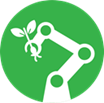Agro Food Robotics
Contact Infrastructure Provider
Summary
Description
 In the field of Agro Food Robotics research and development, WUR is worldwide one of the most experienced and innovative organisation. More than 60 engineers and researchers work together with industrial partners on new robotic systems for agri and food. We design agricultural robotic systems for marine, livestock, open field, horticulture, fresh chains and food, together with many experts on these application fields within Wageningen. Our experts work on sensors to predict yield and quality and we develop robotic systems that are intelligent, robust, hygienic and can work in harsh conditions, robots that learn, run at high speed, are flexible and can cope with big data issues, systems that transfer sensor data into field-maps and management support, and AI systems with learning and decision making skills. Our technology experts specialise in robotic systems’ design, as well as innovations in robot intelligence and sensing. They excel in computer vision, machine learning and spectral imaging.
In the field of Agro Food Robotics research and development, WUR is worldwide one of the most experienced and innovative organisation. More than 60 engineers and researchers work together with industrial partners on new robotic systems for agri and food. We design agricultural robotic systems for marine, livestock, open field, horticulture, fresh chains and food, together with many experts on these application fields within Wageningen. Our experts work on sensors to predict yield and quality and we develop robotic systems that are intelligent, robust, hygienic and can work in harsh conditions, robots that learn, run at high speed, are flexible and can cope with big data issues, systems that transfer sensor data into field-maps and management support, and AI systems with learning and decision making skills. Our technology experts specialise in robotic systems’ design, as well as innovations in robot intelligence and sensing. They excel in computer vision, machine learning and spectral imaging.
With computer vision methods we can accurately analyse data to shape models and models to objective information. Such we can automatically detect various product or plant traits by measuring features such as product size, surface defects, leaf area, or stem length. Existing vision-based systems either focus on speed using 2D imaging, which is consequently inaccurate, or on accuracy using time-consuming 3D methods. We combine strengths of both. E.g. we developed image processing methods for the identification and segmentation of plant organs (e.g. stem and leaf) from 3D plant models. Various measurements of plant features such as plant volume, leaf area, and stem length are estimated based on these plant segments. Another key technology of Agro Food Robotics is the learning capacity of robots, a main part of their intelligence. Through machine learning, it is possible to learn patterns in for example images. Given large amount of training data sets, the artificial intelligence automatically finds ways to teach itself what is in the image, but also where. A strong feature of machine learning is that it can cope with a lot of variation that is present in natural agricultural and food products. Furthermore, once trained, the algorithms can be quickly applied to new cases. But machine learning can also be used beyond images alone. For example to train a robot to grasp, or to find predict yield outcomes The next leap of Agro Food Robotics will have a strong element of machine learning, making robots more flexible and teachable. Within agriculture and food, multi and hyperspectral imaging are among the most powerful imaging methods to measure plant and fruit constituents, plant stress and disease symptoms. With spectral imaging not only one, but multiple values, or a complete spectrum are available per pixel. Therefore, spectral imaging offers more information to detect objects and their location. Also, by applying models, we can measure the spatial distribution of dry matter content, nitrogen status or sugar concentration, or even the concentration of lycopene or chlorophyll. Hyperspectral sensors and imaging techniques have shown an enormous potential for the detection of plant diseases. They provide new insights into plant-pathogen interactions. Within Agro Food Robotics we apply spectral imaging in the range from UV-NIR using different optical technologies. We do projects in the lab, greenhouse and open field. The use of advanced machine learning algorithms, such as deep learning on the 2d or 3d spectral images, makes spectral imaging a particularly suitable technique for many applications within agriculture and food. A robot is a machine that performs work, often hard labour, that humans prefer machines to take over. To be able to do the work, robot combines three main functions: to sense, think and act. The combination of these functions and the design of the robotic system is an expertise on its own. For robot systems in agro food this is even more the case as the environments are often harsh, shows a lot of variation and change in time. To make matters even more complex, also the produce handled varies in size or shape, and changes, e.g. grows or ripens. To be capable of carrying out a complex series of actions automatically in such conditions the robotic system must be designed with know-how of both the various technologies and parts as well as the application. Wageningen experts design robotic systems combining hardware and software to a functioning robot, able to think, sense and act intelligently in agri and food.
https://www.wur.nl/en/research-results/projects-and-programmes/vision-robotics-3.htm